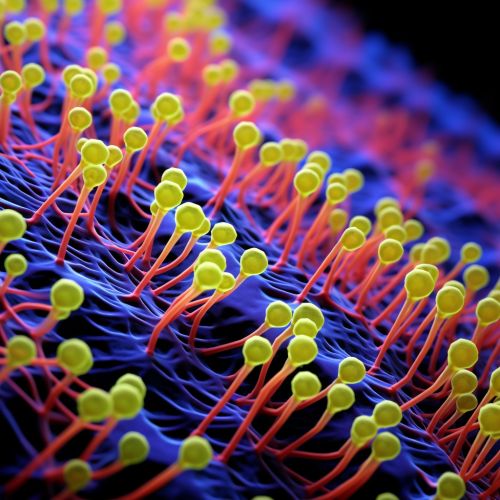Bacteriorhodopsin
Introduction
Bacteriorhodopsin is a type of protein that can be found in the plasma membrane of the Halobacterium salinarum, an archaea that is known for its ability to survive in extremely salty environments. This protein has a unique ability to absorb light and use it to pump protons across the membrane, creating a proton gradient that can be used to generate ATP, the energy currency of the cell. This process is a form of phototrophy, which is the ability of an organism to use light as a source of energy.

Structure
Bacteriorhodopsin is a transmembrane protein, meaning it spans the entire width of the plasma membrane. It is composed of seven alpha helices, which are common structural motifs in proteins. These helices are arranged in a circular pattern, creating a channel through which protons can be pumped.
At the center of this channel is a molecule of retinal, a light-absorbing pigment that is also found in the human eye. When light hits the retinal molecule, it changes shape, triggering a series of conformational changes in the bacteriorhodopsin protein that ultimately result in the pumping of a proton across the membrane.
Function
The primary function of bacteriorhodopsin is to generate a proton gradient across the plasma membrane of Halobacterium salinarum. When light hits the retinal molecule in the center of the protein, it triggers a series of conformational changes that result in a proton being pumped from the inside of the cell to the outside. This creates a gradient of protons, with a higher concentration outside the cell than inside.
This proton gradient can then be used to generate ATP through a process known as chemiosmosis. This is the same process that is used in the mitochondria of eukaryotic cells to generate ATP during cellular respiration.
Applications
Due to its unique light-absorbing properties, bacteriorhodopsin has been the subject of much research and has potential applications in a variety of fields. For example, it has been used in the development of bioelectronic devices, such as light-driven proton pumps and photovoltaic cells. It has also been used in the field of optogenetics, where it can be used to control cellular processes with light.
In addition, the structure of bacteriorhodopsin has been studied extensively as a model for G protein-coupled receptors, a large and important family of proteins that are involved in many cellular processes and are the target of many drugs.
